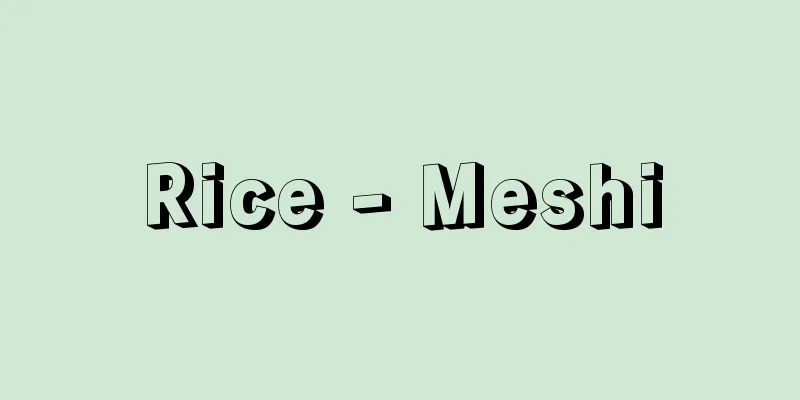Rice - Meshi

|
Originally it was a general term for cooked grains, but generally it refers to rice cooked with water. It is called "meshi," "ii," or the onomatopoeic form "han." Today it is more commonly called "gohan," but "meshi" is also widely used. In the past it was called "meshi," "mimeshi," or "meshimono," which were derived from "mesu," and these evolved into "meshi." Also, during the Heian period, the rice used by nobles was called "omono," "kugo," or "odai." [Tomomi Kono and Midori Otaki] kindsThere are many types of rice cooked by mixing other grains with rice, and they are named after the ingredients they are mixed with, such as barley rice (mugimeshi), millet rice (hiemeshi), millet rice (awameshi), red bean rice (azukimeshi), and soybean rice (daizumeshi). In addition, there are many other types, such as gomokumeshi (mixed rice) with various ingredients, mixed rice, sakurameshi colored with soy sauce, and ouhan (yellow rice) colored with gardenia. In addition, there are distinctions based on the rice used, such as white rice (hakuhan) made with polished rice, germ rice (haigamai) made with germ rice, brown rice (genmemeshi) made with brown rice, and semi-polished rice (hantsukimeshi) based on the degree of polishing of the rice. [Tomomi Kono and Midori Otaki] historyIn the old days, rice was steamed to make rice. In other words, up until the Heian period, rice meant today's "okowa," or steamed rice, and was called kowaii. Rice cooked with a lot of water was called kayu. Porridge cooked with less water was called katakayu, yowai, or hime-meshi, but the kanji character hime was sometimes used. In addition to kowaii and kayu, aristocrats also used mizumeshi and yumeshi (rice made by soaking kowaii or hoishii, steamed and dried grains, in water or hot water). Hime-meshi gradually became more popular from the end of the Heian period, but ordinary people usually cooked brown rice mixed with foxtail millet, barley, Japanese barnyard millet, dried radish leaves, and wild vegetables. [Tomomi Kono and Midori Otaki] Cooking methodSince ancient times, there have been various ways of cooking rice, such as takiboshimeshi (cooked and dried), yudorimeshi (boiled and boiled), and futatabimeshi (twice cooked). Takiboshimeshi is the method of cooking rice commonly used today, while yutorimeshi involves first lightly boiling the rice in a large amount of water, washing off the sticky surface, and then finishing by steaming. Outside of Japan, this method was widely used for cooking rice. Nidomeshi refers to rice where water is added to yutorimeshi and boiled again to soften it, or where hot water is added to cold rice to warm the rice, the water is drained, and the rice is steamed to finish it. [Tomomi Kono and Midori Otaki] keepRice is made when starch is heated with water and the starch becomes alpha (α) starch. Once alpha starch is left in a moist environment for a long time, it will go through a aging phenomenon and become dry. This is especially likely to occur when the temperature is low. Also, when the temperature is high, bacterial decay progresses and the rice becomes stringy. Sugar and other ingredients are effective in preventing aging, so if you eat sweet rice, such as in a bento box, after a while, the starch will not aging and the taste will not deteriorate. Also, if you add a small amount of vinegar when cooking rice in the summer when the temperature is high, the acid will kill many bacteria during heating, making it less likely to spoil. Also, when cooking rice at high temperatures such as in a pressure cooker, the sterilization rate is high and it is relatively resistant to spoilage. [Tomomi Kono and Midori Otaki] Brown riceBrown rice contains more vitamins and minerals than white rice, and is often recommended for health reasons. It also contains a lot of dietary fiber, which is an indigestible substance, which has the advantage of having a positive effect on the digestive system, promoting the proliferation of intestinal lactic acid bacteria, and synthesizing vitamins in the intestines. However, it also reduces the absorption of other nutrients, so caution is required for those who need a lot of nutrients during their growth period and elderly people who are eating less, as they may not be able to obtain enough of the necessary nutrients, which can be harmful to their health. [Tomomi Kono and Midori Otaki] FolkloreIt was only after the Second World War, when a rationing system was established, that rice became a staple food for the entire nation; before that, rice was only eaten on special occasions such as Obon, New Year, festivals, and seasonal festivals. Usually, people ate meals such as barley rice, millet rice, barley rice, soybean rice, and pea rice, which were made by mixing rice with grains such as wheat and millet, called keshine (everyday rice), or three-grain rice, which was made by mixing several grains, or radish rice, potato rice, and bamboo shoot rice, which were made by mixing vegetables, potatoes, and seaweed. Matsutake rice, chicken rice, and mixed rice were also developed from meals, and were considered delicacies. Cooking rice in a pot on a hearth is a relatively new practice, and many regions cooked rice in a pot hung on a hook over the hearth until before World War II. Barley rice and kate rice were cooked using the yutori method, which involves squeezing out the sticky liquid and letting it flow, so a pot was convenient. When white rice became more common, rice was cooked in a yakitori method, so a pot with a thick, heavy lid was most suitable. Special occasion meals include red rice and red rice. Red rice is made by steaming glutinous rice with boiled red beans and cowpeas, and is said to be related to red rice, an old variety of rice, which has been colored red by passing down the traditional food preparation method of mixing grains and steaming the rice. Red rice is made by cooking non-glutinous rice with hyacinth beans. Many people think of red rice as a special occasion food, but in some places it is made for funerals, so it was a special occasion food that was different from everyday food. However, in many regions, red rice for funerals is distinguished from red rice for special occasions by sprinkling crushed sesame seeds on it. In the past in Japan, there were portable foods such as hoshii and tonjiki, but rice balls were the most common portable food. Barley rice, once the most common staple food, came in many varieties depending on the era. Rice made from cooked whole barley, known as marumugi, was called subaku, bakumeshi, mugiissou, mugizokki, etc. Hikiwari and warimeshi, made by grinding barley in a stone mill, had a smoother texture than plain barley. Pressed barley is the most recent and widespread way to eat it. Barley rice was also made into meals such as vegetable barley and barley porridge, but the proportion of barley to rice decreased over time. [Kensaku Uchida] "Hiroshi Fukuda and Yutaka Yamamoto, "Porridge - Rice Porridge, Rice with Soup, Rice Porridge, Foamed Rice and Rice Porridge Side Dishes" (2002, Shibata Shoten)" ▽ "Rural Culture Association (ed.), Okumura Hideo (commentary, Hometown Home Cooking 2, Mixed Rice and Katemeshi)" (2003, Rural Culture Association) [Reference] | | | | |Source: Shogakukan Encyclopedia Nipponica About Encyclopedia Nipponica Information | Legend |
|
本来は穀類を炊いたものの総称であったが、一般には米に水を加えて炊いたものをいう。「めし」「いい」または字音で「はん」といっている。現在は「ごはん」という呼び方が一般的であるが、「めし」も広く使われている。古くは「召す」の名詞化「召し」「御食(みめし)、食物(めしもの)」といい、これから「めし」に転じたのである。また、平安朝のころ高貴の人が用いる飯は「御物(おもの)」「供御(くご)」「御台(おだい)」などといった。 [河野友美・大滝 緑] 種類米に他の穀類などを混ぜて炊飯するものが数多くあり、混ぜる材料の名を冠して麦飯(むぎめし)、稗飯(ひえめし)、粟飯(あわめし)、小豆飯(あずきめし)、大豆飯(だいずめし)などがある。このほか、各種の具を加えた五目飯(ごもくめし)(かやく飯)、混ぜご飯、しょうゆで色づけした桜飯、クチナシで色づけした黄飯(おうはん)など種類が多い。また、使用する米により、精白米を使用したものを白飯(はくはん)、胚芽米(はいがまい)を使用した胚芽飯(めし)、玄米を使う玄米飯、米の搗精(とうせい)度により半搗(はんつ)き米飯といった区別もある。 [河野友美・大滝 緑] 歴史古くは飯をつくるために米を蒸した。つまり、平安時代までは、飯は今日の「おこわ」すなわち米を蒸したものをいい、これを強飯(こわいい)とよんだ。米に水を多く加えて煮たものは粥(かゆ)といった。粥のうち水を少なくして炊いたものは硬粥(かたかゆ)、弱飯(よわいい)または姫飯(ひめいい)といったが、糄(ひめ)という漢字を用いることもあった。貴族たちは強飯や粥のほかに水飯(みずめし)・湯飯(ゆめし)(強飯や、穀類を蒸して乾燥させた糒(ほしいい)を水や湯に浸した飯)も用いた。平安末期から姫飯がしだいに広まったが、一般民衆は玄米にアワ、ムギ、ヒエや、ダイコンの干葉(ひば)、山菜などを混ぜて炊くのが常であった。 [河野友美・大滝 緑] 炊飯法古くから飯の炊き方には、炊乾(たきぼし)飯、湯取(ゆどり)飯、二度(ふたたび)飯などの種類があった。炊乾飯は今日の通常行われている炊飯法であり、湯取飯は、いったん米を多量の湯で軽くゆで、表面の粘(ねば)を洗ったのち蒸して仕上げる。日本以外では、この方法で炊くところが多かった。二度飯は、湯取飯に水を加えもう一度煮て柔らかくしたものや、冷や飯に湯を加えて飯を温めたのち湯を抜き、蒸し上げて飯に仕上げるものをいう。 [河野友美・大滝 緑] 保存飯はデンプンが水とともに加熱されてデンプンがα(アルファ)化したものである。いったんα化したデンプンは、水分の多い状態で長く放置すると、デンプンが老化現象をおこし、ばさばさした状態になりやすい。とくに気温が低い場合にこれがおこりやすい。また、気温の高いときには、細菌による腐敗も進み、糸を引くようになる。老化の防止には、砂糖などが効果があるから、甘味のきいた飯などにすれば、弁当などとして、時間が経過して食べる場合ではデンプンの老化が防止でき、味が低下しにくい。また、夏季など気温の高いときには、炊飯時に少量の酢を加えると、酸によって加熱の際に菌が多く死滅するから腐敗しにくい。また、圧力鍋(なべ)のような高温で炊飯した場合も殺菌率が高く、比較的腐敗しにくい。 [河野友美・大滝 緑] 玄米飯玄米飯は、白飯よりもビタミンやミネラルが多く、健康上推奨されることが多い。また、不消化物である食物繊維を多く含み、これが消化器によい影響を与え、腸内乳酸菌などの繁殖を促し、腸内のビタミン合成を行う利点がある。しかし、他の栄養素の吸収を低下させる点があり、成長期で多くの栄養成分を要する者や、食が少なくなっている高年者では必要な栄養成分が十分にとれないため、健康を害することもあるから注意が必要である。 [河野友美・大滝 緑] 民俗米が国民全体の常食となったのは第二次世界大戦後、配給制度が確立してからで、それまでは米の飯は盆・正月・祭り・節供(せっく)などのハレの日に限られていた。普段は、米にケシネ(褻稲)とよぶ麦・粟(あわ)などの雑穀を混炊した麦飯・粟飯・稗飯(ひえめし)・大豆飯・豌豆飯(えんどうめし)、雑穀数種を混ぜた三穀飯(さんごくめし)、あるいは野菜・芋・海藻などを混炊した大根飯・芋飯・筍飯(たけのこめし)などのかて飯(めし)を食していた。松茸(まつたけ)飯・鳥飯・五目飯などもかて飯が発達したものであるが、これは御馳走(ごちそう)とされた。竈(かまど)に釜(かま)をかけて飯を炊くようになったのは比較的新しく、第二次世界大戦前まではいろりの自在鉤(じざいかぎ)に鍋(なべ)をかけて炊く地方が多かった。麦飯やかて飯はオネバを絞り流して炊く湯とり法で炊事したので、鍋が便利だったのである。白米食が普及すると、米の飯は炊き干しで炊くので蓋(ふた)が厚くて重い釜がもっとも適していた。 ハレの日の飯には赤飯と赤の飯がある。赤飯は糯米(もちごめ)にゆでた小豆(あずき)や大角豆(豇豆)(ささげ)を入れて蒸した強飯(こわめし)で、雑穀混炊と蒸し飯の伝統的食品調理法を伝え、赤く着色するのは、米の古い品種である赤米に連なるものといわれる。赤の飯は粳米(うるちまい)に大角豆を入れて炊いたものである。赤飯は祝い事のものと考える人が多いが、葬式のときにつくる所もあり、要するに普段と違ったハレの日の食べ物だったのである。ただし、葬式のときの赤飯は、ゴマをすりつぶしてかけるなど、祝い事の赤飯とは区別している地方が多い。 日本では、古く携帯食として糒(ほしいい)や屯食(とんじき)があったが、握り飯はもっとも一般的な携帯食である。 かつてもっとも一般的な主食だった麦飯も、時代によっていろいろの種類があった。丸麦というまるのままの大麦を炊いた飯は、素麦(すばく)、麦飯(ばくめし)、ムギイッソウ、ムギゾッキなどといわれた。大麦を石臼(うす)で挽(ひ)いて挽き割りにしたヒキワリ、ワリメシは、素麦に比べ口あたりがよかった。押し麦はもっとも新しく普及した食法である。麦飯にも野菜麦(やさいばく)や麦粥(ばくがゆ)などのかて飯も行われたが、米に対する麦の割合が時代とともに減少していった。 [内田賢作] 『福田浩・山本豊著『おかゆ――粥・汁かけ飯・雑炊・泡飯と粥のおかず』(2002・柴田書店)』▽『農山漁村文化協会編、奥村彪生解説『聞き書・ふるさとの家庭料理2 混ぜごはん・かてめし』(2003・農山漁村文化協会)』 [参照項目] | | | | |出典 小学館 日本大百科全書(ニッポニカ)日本大百科全書(ニッポニカ)について 情報 | 凡例 |
>>: Mezamashi Newspaper - Mezamashi Newspaper
Recommend
Architectural decoration
Decoration added to architecture. It is unclear wh...
Pheasant cat - Kijineko
… At first glance, the coat colors and markings o...
Coming of Age Soga
(1) The title of a piece from the Kowaka dance. It...
Jean François de Galaup, Comte de La Pérouse
1741‐88 French Pacific explorer. Joined the navy i...
Whistler
...A general term for birds of the passerine orde...
Grupo de Oficiales Unidos
…He was sent to Italy to study military affairs f...
Cold agglutination
This is a method to detect cold agglutinin, an ant...
Aguirre Administration
… However, from 1864 to 1870, the Empire faced tw...
poke
…The whole plant resembles pokeweed, but the flow...
Gehyra mutilata (English spelling) Gehyramutilata
...They lay eggs once or twice a year, two at a t...
Bipalabi (English spelling)
…He volunteered for the Bengal regiment during th...
Rudolf Slánský
Czechoslovak politician. Born into a Slovakian Je...
Toa Kogyo Co., Ltd. - Toa Kogyo Co., Ltd.
A national policy company founded in 1909 at the s...
Gosainthan
...Located in Tibet, it has an elevation of 8,013...
Oguz Kagan - Oguz Kagan
…A legend, tale, or heroic epic poem passed down ...






![Yagi [town] - goat](/upload/images/67cd096600913.webp)


